FAQs about Morays Eel Identification 8
Related FAQs: Moray IDs 1, Moray IDs 2, Moray
IDs 3, Moray IDs 4, Moray IDs 5, Moray IDs 6,
Moray IDs 7, Moray IDs 9, &
Moray Eels 1, Moray Eels 2, Moral
Eels 3, Moray Selection,
Moray Behavior, Moray Compatibility, Moray Systems, Moray Feeding, Moray Disease, Moray Reproduction, Zebra Moray Eels, Snowflake Morays, Freshwater Moray Eels,
Other Marine Eels,Related Articles: Moray
Eels, Zebra Morays, Snowflake Morays, Ribbon Morays, The "Freshwater" Moray
Eels, Freshwater Moray
Eels by Marco Lichtenberger,
Other Marine
Eels,
|
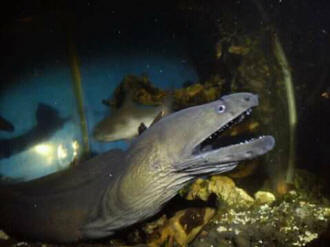
|
|
Re: Moray Eel identification
11/17/20
Very sorry sir. I am attaching a single 13kb image file this time.
<Hey James; this one is indeed too small (shades of Goldilocks and the
Three Bears!). Something in the few to several hundred KByte range is what
we're looking for. Bob Fenner>
Re: Moray Eel identification 11/17/20
Very sorry sir. I am attaching a single 13kb image file this time.
<Good morning, James. I think maybe you overdid the resizing a bit here!
160 × 90 pixels is way too small to see anything! Just out of curiosity, is
this a marine Moray or one of the 'freshwater' species? The answer to that
question will speed things up, especially if you can send along a somewhat
bigger photo. Something like 1200 x 800 pixels is good! Cheers, Neale.>
|
 |
|
Re: Moray Eel identification
11/17/20
I think I got it right this time. 455kb image file attached. Need help
identifying this moray eel. Thank you, James D.
<Hi James, usually I'd have said Gymnothorax melatremus due to the color
alone, but the eyes are not right, since Gymnothorax melatremus has a
vertical bar in the eye. If the eel in question really has this yellow to
orange color only a few other morays come to mind e.g. G. prasinus from
Australia (unlikely to be seen in trade elsewhere) and the yellow color
morph of Gymnothorax miliaris from the Atlantic Ocean. Any idea, where it
came from? Cheers, Marco.>
|
_Easy-Resize.com%20(1)_Easy-Resize.com%20(2).jpg) |
|
Re: Moray Eel identification
1/18/20
Hello Marco, my supplier says it came in from Africa actually.
I am attaching a web address of the only photo i can find online. very
clear picture here:
https://www.flickr.com/photos/aey/4713980205
<Hello James. Back when I was importing almost all imports of morays from
Africa were from Kenya, and this does not look like one of the 10 species
recognized from Kenya's coast to my knowledge. However, in the Western
Indian Ocean in general Gymnothorax herrei (my best guess here) can occur,
which looks somewhat similar:
https://www.fishbase.se/photos/PicturesSummary.php?StartRow=0&ID=7491&what=species&TotRec=3
and
https://www.fishbase.se/photos/PicturesSummary.php?StartRow=1&ID=7491&what=species&TotRec=3
when small. Michael's Reef Fishes vol. 1 also has a orange to brown species
G. brunneus, which is seen my many as a synonym for G. herrei. It's a rather
along shot, but the best I can do on your pic. In addition, it is still
possible it is some undescribed species of moray, of which there are still
quite a number. Great specimen and find. Cheers, Marco.>
<PS: Picture links to G. herrei might not work in my last email. Here they
are corrected:
https://www.fishbase.se/images/species/Gyher_u0.jpg and
https://www.fishbase.se/images/species/Gyher_u2.jpg. Cheers, Marco.>
Re: Moray Eel identification 1/18/20
Thank you Marco, the juvenile stage of both species you mentioned bare a
very close resemblance to my species. If none of my customers purchase the
animal this weekend I will put it in my show tank and see what he turns
into! Thanks again! James D.
Re: Moray Eel identification 1/19/20
Thank you Marco, the juvenile stage of both species you mentioned bare a
very close resemblance to my species. If none of my customers purchase the
animal this weekend I will put it in my show tank and see what he turns
into! Thanks again! James D.
<You are welcome, James. I am also curious how it looks in a year or two.
Cheers, Marco.>
|
Trying to id an eel. Sans pix?!
6/11/18
We saw these amazing little eels on our beach walk today that
neither my partner or I have ever seen before. They were in a tide pool
at low tide and one would've been about 20cm, the other maybe 30cm-ish.
It had a black/dark vertical band around its "neck" with almost a clown
fish head and white pectorals and dorsal fins. Then it had one white
horizontal stripe down either side of its body, with a thinner black one
running parallel within it. It's body was kinda like a pastel peach,
similar to a clown fish but more yellow, sorry I don't really know how
else to describe it. But I haven't been able to find out anything via
web/book searches. I thought maybe they could've been juveniles but I am
at a loss. I live in tropical Far North Queensland in Australia by the
way. Any help would be so appreciated!
<There are several eels with these characteristics and without an image
its hard to make a guess as they may be either of the genus Gymnothorax
or Echidna, both in the family Muraenidae.
Bob, any guess here?>
<<W/o (clear) images? No. RMF>>
Kind regards,
Rachel
<Wilberth>
|
Various types of Morays that are usually caught in the rivers in
Indonesia 12/20/17
Good evening Neale and all of you beautiful people at WetWebMedia.
Greetings from Jakarta!
<And a howdy to you too, Ben.>
(Neale, your hometown "Berkhamsted", from the name, which sounds archaic, I
assume this is a very old historic town with a castle surrounded by moats.
Must be a wonderful tourist attraction!)
<Well, it's quite pretty I suppose. But it's home!>
I'd like to present some of the pictures from Mr. Septian, my friend in
Yogyakarta, Indonesia, who specializes in capturing and selling moray eels from
the rivers in that province, to ornamental fish lovers. He had sold them all,
but he still has many in stock.
As you can see, he routinely captured the usual suspects of G. Polyuranodons and
G. Tiles, but he also had captured some not-so-usual morays in the past, such as
Strophidon sathetes, G. Undulatus, and some others I cannot recognize. All were
caught in the river, not far from the estuarium, just a few kilometers.
Interesting eh? Make me even more interested to go there and sample the water!
<Oh, absolutely! One thing to remember though is vertical stratification is VERY
common in estuaries. In other words, dense seawater moves along the bottom of
the estuary, like a wedge. Less dense freshwater floats on top.
https://en.wikipedia.org/wiki/Estuarine_water_circulation
So you will find freshwater fish in the top few metres, but marine fish at the
bottom, and for all practical purposes the two kinds of environment don't mix.
Some fish can of course swim between salt and freshwater -- many
puffers for example -- while others stick very much to their preferred salinity.
So even if a river estuary is several km inland, the bottom could easily be
almost fully marine conditions, whereas the top few metres might be more or less
completely freshwater. Strong currents (such as upwelling) can cause mixing, but
if the river is slow and ambling gently towards the sea, there might be very
little mixing. This means that if you dip your hydrometer into the water next to
the riverbank, you might detect a very low salinity; but if you put a baited
trap on the bottom to catch fish living there, you might be catching fish from
the salty, near-marine environment at the bottom.>
As for my own eels, I will try to feed my eels again tonight with frozen shrimps
and squids. Mr. Emerson (the largest) loves frozen shrimps now, but the other
two are still not interested. If they reject the squids, I will
make myself fried calamari for dessert ;)
<Yum!>
Thank you and have a nice day!
Best regards,
Ben
<And to you, best wishes, Neale.>
|
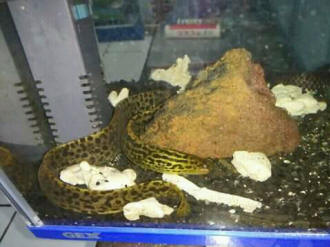

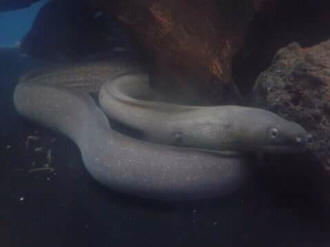
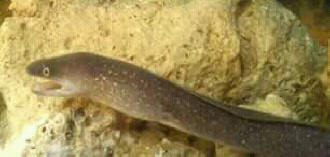
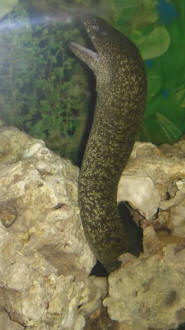
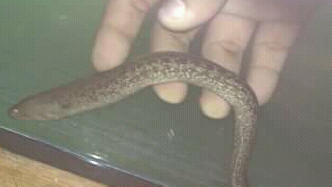
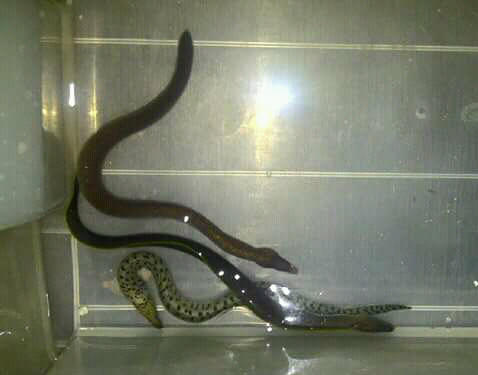
Re: fw: Various types of Morays that are usually caught in the
rivers in Indonesia 12/21/17
Marco; thought you'd find this message/post interesting. BobF
<Thanks. Indeed is!>
Cheers mate. B
Various types of Morays that are usually caught in the rivers in Indonesia
/Marco 12/21/17
Good evening Neale and all of you beautiful people at WetWebMedia.
Greetings from Jakarta!
<Hi Ben.>
(Neale, your hometown "Berkhamsted", from the name, which sounds archaic, I
assume this is a very old historic town with a castle surrounded by moats.
Must be a wonderful tourist attraction!)
I'd like to present some of the pictures from Mr. Septian, my friend in
Yogyakarta, Indonesia, who specializes in capturing and selling moray eels
from the rivers in that province, to ornamental fish lovers. He had sold
them all, but he still has many in stock.
As you can see, he routinely captured the usual suspects of G. Polyuranodons
and G. tiles, but he also had captured some not-so-usual morays in the past,
such as Strophidon sathetes, G. undulatus, and some others I cannot
recognize. All were caught in the river, not far from the estuarium, just a
few kilometers. Interesting eh? Make me even more
interested to go there and sample the water!
<Indeed. Especially the S. sathete looks amazing! Most common in estuaries
and can grow well beyond 3 m. I can also see Gymnothorax richardsonii (known
as the dish "Bakasi" around the city of Cordova on Cebu) and Gymnothorax
fimbriatus in the pictures you sent. All of the above have been reported
from brackish waters, even G. fimbriatus. Can't see G. undulatus in the
pictures, but it's reported from brackish waters, too, so it's well
possible.>
As for my own eels, I will try to feed my eels again tonight with frozen
shrimps and squids. Mr. Emerson (the largest) loves frozen shrimps now, but
the other two are still not interested. If they reject the squids, I will
make myself fried calamari for dessert.
<Kept G. polyuranodon in the past for many years. Various fish species were
the favourite food, but shrimps, clams and calamari were also eaten when
hungry.>
Thank you and have a nice day!
<You too.>
Best regards, Ben
<Cheers, Marco.>
|
|
|

